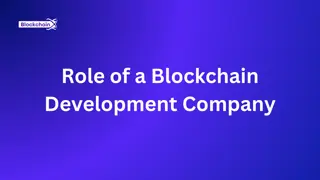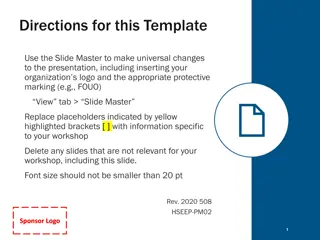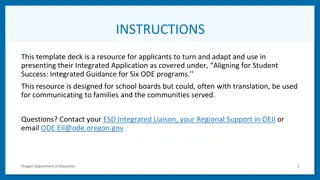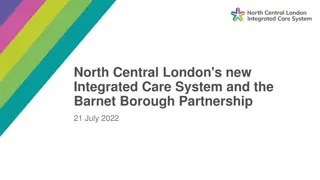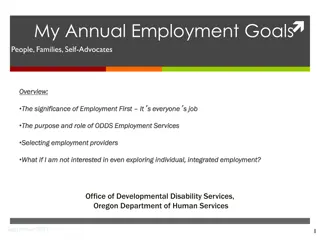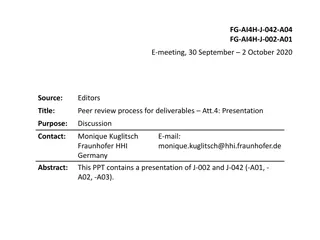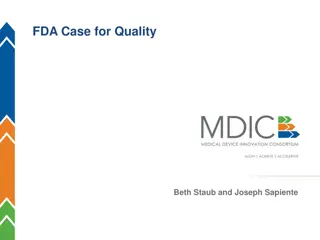
Integrated Data as a Foundation for Systems Engineering Whitepaper
This whitepaper by the INCOSE Requirement Working Group focuses on implementing Systems Engineering through a data-centric approach, addressing key areas, goals, and guidance. It emphasizes the importance of integrated data for MBSE and provides a roadmap for organizations to enhance their SE capabilities.
Download Presentation

Please find below an Image/Link to download the presentation.
The content on the website is provided AS IS for your information and personal use only. It may not be sold, licensed, or shared on other websites without obtaining consent from the author. If you encounter any issues during the download, it is possible that the publisher has removed the file from their server.
You are allowed to download the files provided on this website for personal or commercial use, subject to the condition that they are used lawfully. All files are the property of their respective owners.
The content on the website is provided AS IS for your information and personal use only. It may not be sold, licensed, or shared on other websites without obtaining consent from the author.
E N D
Presentation Transcript
Integrated Data as a Foundation for Systems Engineering Document No.: INCOSE-TP-2018-001-01 Version/Revision: 1.0 Date: Dec 20, 2018 Prepared by the INCOSE Requirement Working Group (RWG) www.incose.org/IW2020
January 21, 2020 IW2020 2
January 21, 2020 IW2020 3
Preface This whitepaper is an outgrowth from discussions concerning the RWG participation in and collaborating with the MBSE Initiative that occurred within the RWG sessions during INCOSE IW 2016 and IW2017 in Torrance, CA and subsequent communications between the authors, members of the RWG, and members of other INCOSE Working Groups. January 21, 2020 IW2020 4
Purpose The purpose of this whitepaper is to help organizations implement Systems Engineering by addressing the following areas: Help organizations understand that the data-centric approach to practicing SE advocated in this whitepaper is a major part of MBSE. Outline the importance for an organization to keep track and manage data and information across all the system life cycle process activities. Provide guidance regarding the management principles and decisions important to the implementation and management of SE from a data-centric perspective. Propose a method that can be used to measure and benchmark an organization s capability to practice SE from a data-centric perspective. Furnish guidance and a roadmap to help an organization move towards practicing SE from a data-centric perspective. January 21, 2020 IW2020 5
Goals Expanding on the concept of SE from a data-centric perspective, the goals of this whitepaper are to: Present a broader data-centric perspective of SE that meets the intent the MBSE initiative. Provide organizations an understanding that integrated (federated), shareable sets of data are a key foundation of SE. Provide an integrated context of the various perspectives of MBSE which can be built upon and expanded on by the various INCOSE Working Groups, SE tool vendors, and practitioners of SE. The overall goal is to make this whitepaper a useful product to help organizations implement the level of SE capability that best fits their needs. The overall goal is to make this whitepaper a useful product to help organizations implement the level of SE capability that best fits their needs. January 21, 2020 IW2020 6
Intended Audience Project and product managers and systems engineers who are stakeholders in activities defined by the SE discipline and are thinking about, or are in the process of, implementing SE within their organization. Those who are wondering how to successfully implement the intent of the MBSE Initiative within their organization and those that are interested in maturing their current SE capabilities toward a more data-centric implementation of SE - irrespective of the size and complexity of the system under development and the size and culture of the organization developing the system. January 21, 2020 IW2020 7
This guide is also targeted to: From a requirements perspective, this whitepaper is also targeted to those who have been, or are currently, focused on defining, documenting, and managing requirements as a distinct and separate, siloed activity from other system life cycle process activities. From a tool vendor perspective, this whitepaper is targeted to those whose tools do not provide the capability to integrate and share requirements and the other work products and their underlying data and information across all system life cycle process activities. While these approaches may have worked in the past and may work for some present system development efforts, it is doubtful these approaches will allow organizations to meet the future challenges of increasingly complex systems. January 21, 2020 IW2020 8
Table of Contents January 21, 2020 IW2020 9
Table of Contents January 21, 2020 IW2020 10
SE Capability Levels (SCLs) Example- SCL 0 Area of Capability Current state The system life cycle process activities are divided across organizational units operating in silos. Organization The enterprise has no documented data and information governance policy, processes, and procedures. Enterprise Level Data & Governance Policy, Processes, & Procedures Project level Data and Information Management Master Ontology Master Schema Projects have not included data management concepts in their PMP nor SEMP and have no IMP. There is no defined master ontology for the enterprise nor project. The project does not store data in a database so there is no defined master schema for the project. The primary SE toolset used by the project is limited to common office applications: word-processing, spreadsheets, presentations, and basic drawing and diagraming tools. The primary PM toolset used by the project is common office applications: word-processing, spreadsheets, and presentations. The primary focus of the project is on hardcopy, printed documents, design description documents, ICDs, CAD drawings, etc. While the files representing work products are stored electronically, they exist as independent files (vs. in a database containing underlying data) making it difficult to share information contained within the files other than with other office applications (copy/paste). Systems Engineering (SE) Tool Set Project Management (PM) Tool Set Work product Format Shareability of data and information Few, if any, work products are linked together across system life cycle process activities making it is difficult to identify and manage dependencies between work products. Any traces between requirements is done manually, if at all. Linking (Traceability) between work products developed in different development life cycles Consistency of data across work products There are often inconsistencies between and within work products. It is difficult to assess completeness of data and information within work products. Completeness of work products Few, if any, SE work product attributes and measures are defined and used to help manage the project. PM measures focus on schedule and budget. The project baselines and configuration manages individual printed documents or electronic versions of the printed documents (e.g., pdf files). The single source of truth of project's data and information is represented by these baselined and configuration managed documents. Use of work product attributes and associated measures Configuration Management January 21, 2020 IW2020 11
Information Model The RWG produced this whitepaper from the perspective that requirements, along with all work products (models, designs, documents, diagrams, drawings, etc.) generated during the performance of system life cycle process activities are represented by underlying sets of data and information. Data and information in these sets need be able to be accessible and shared between organizations and PM and SE tools used within an organization as well as external organizations. This sharing will help to ensure consistency, correctness, and completeness of work products developed across all system life cycle stages. To enable this sharing of data and information, the project/program needs to manage these sets of data in a way that enables sharing of the data across all system life cycle stages. January 21, 2020 IW2020 12
Data-centric Perspective of SE The authors believe this data-centric perspective of SE provides an alternate lens through which to acquire a more complete understanding of the system life cycle process activities and resulting work products and underlying data and information needed to manage the development of increasingly complex systems of the future. This perspective aids in acquiring a practical understanding of the system life cycle process activities from the perspective of not only models, but all work products that are generated from activities conducted during each of the system life cycle process activities and the underlying data and information used to represent these work products. January 21, 2020 IW2020 13
SE from a Data-Centric Perspective defined: SE, from a data-centric perspective, involves the formalized application of shareable sets of data to represent the SE work products and underlying data and information generated to support concept maturation, requirements development, design, analysis, and verification and validation activities throughout the system life cycle, from conceptual design to retirement. January 21, 2020 IW2020 14
Integrated data as a foundation of SE Processes Budgets Measures Drawings & Diagrams Designs Models Data Rqmts Schedules Needs Risks Plans Information Management DB Administration Configuration Control Data Governance Guides Standards Integrated or Federated Shareable Sets of Data Policies Procedures Drawings & Diagrams Reports Other Life-cycle work products Plans Rqmts Models Simulations Designs Original Developed by INCOSE RWG at IW 2017 January 21, 2020 IW2020 15
The basic premises of this document are: Using this perspective, integrated (or federated), shareable sets of data can be viewed as a foundation of Systems Engineering. From this data-centric perspective of SE, there are many key benefits that will aid organizations in successfully meeting the challenges associated with today s ever increasingly complex systems, meeting the intent of the MBSE Initiative, and helping organizations move toward INCOSE s Vision 2025. January 21, 2020 IW2020 16
The shareable, integrated dataset is the foundation of all SE lifecycle activities The data-centric SE perspective focuses attention on the common, shareable integrated dataset that underpins all SE activities, including Modeling the system being developed Modeling the SE lifecycle processes Generation and management of all SE work products and their underlying data and information A data-centric SE perspective is essential to: Manage the system development efforts across all lifecycles, Address the challenges of increasingly complex systems, Meet the intent of INCOSE s MBSE Initiative Move towards INCOSE s Vision 2025. January 21, 2020 IW2020 17
Questions? IW2020 18 January 21, 2020


